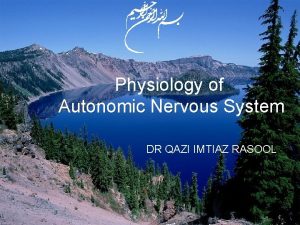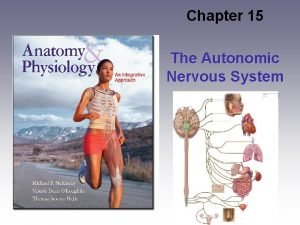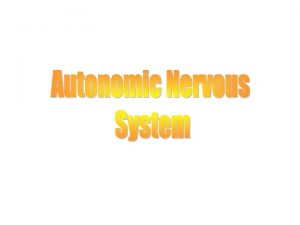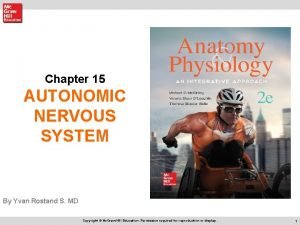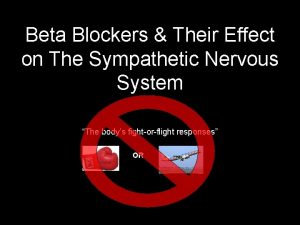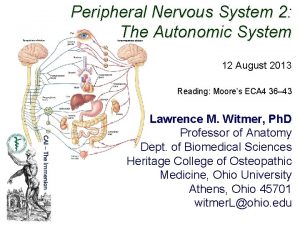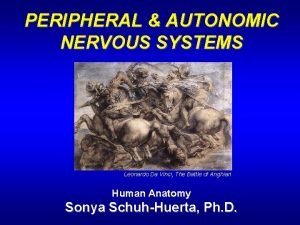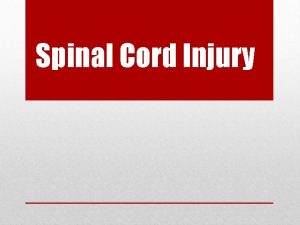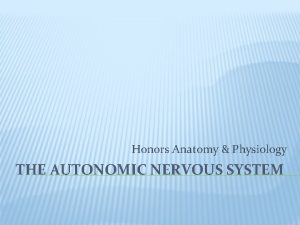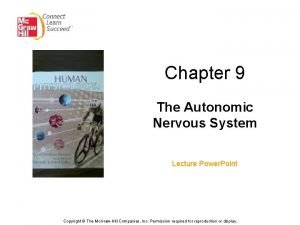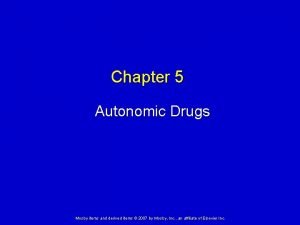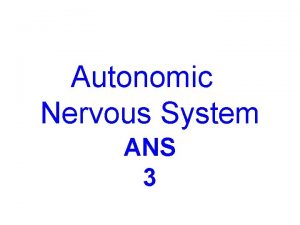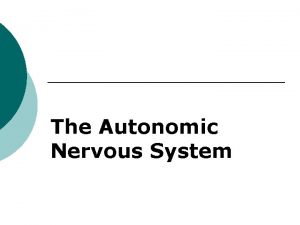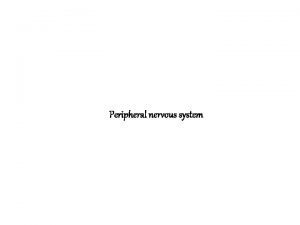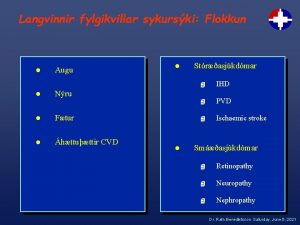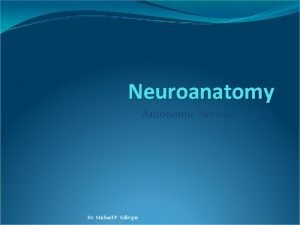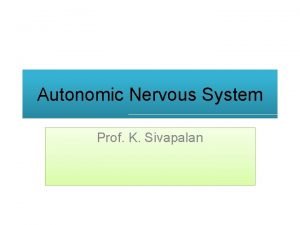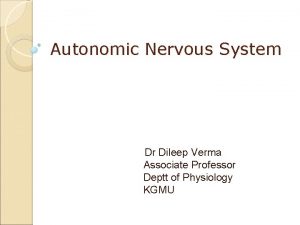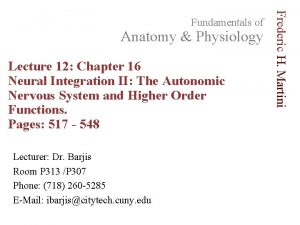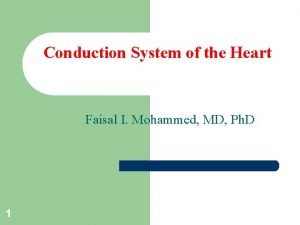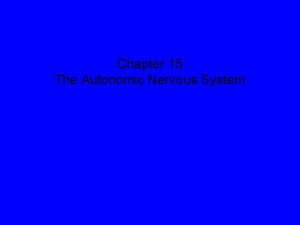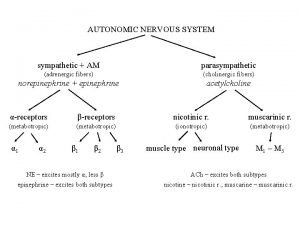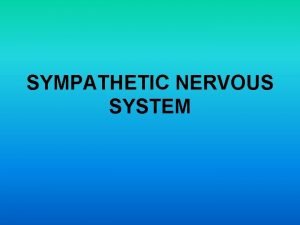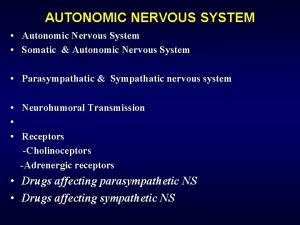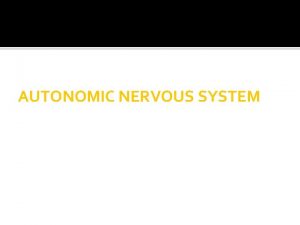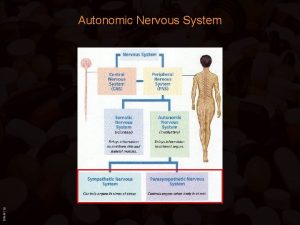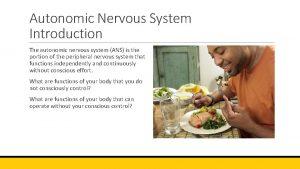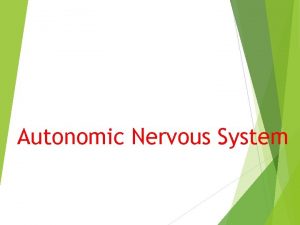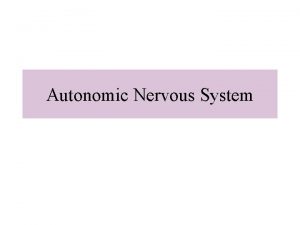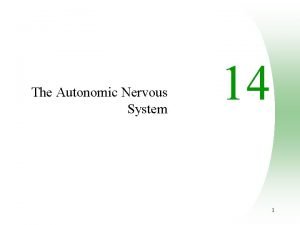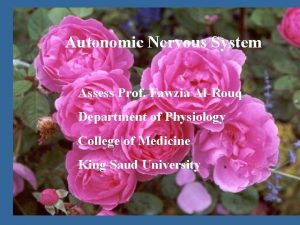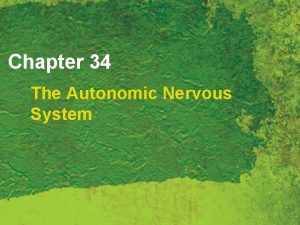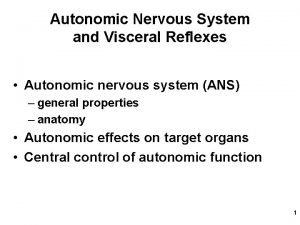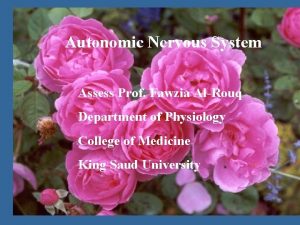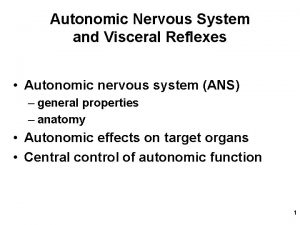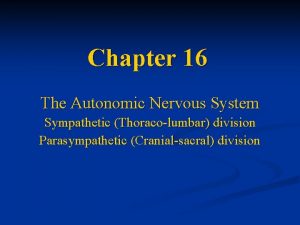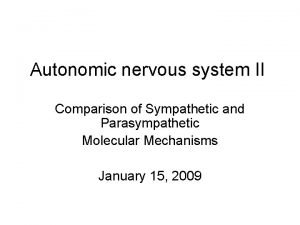AUTONOMIC NERVOUS SYSTEM 23 Sympathetic nervous systems 24
















































- Slides: 48

AUTONOMIC NERVOUS SYSTEM 23. Sympathetic nervous systems 24. Parasympathetic nervous systems. Autonomic innervation and reflexes Semmelweisof University, Faculty of Medicine 3 rd semester pelvic organs Katalin Kocsis Department of Anatomy, Histology and Embryology 2018. 10. 30. .

Functions of the autonomic nervous system • • Sympathetic: Body response to stressful situations. (Acceleration of heart, elevation of blood sugar, increased blood flow to skeletal muscle, piloerection, pupillary dilatation, elevation of blood pressure) FIGHT or FLIGHT response. Parasympathetic: Main role is conservation and restoration of body energy. (Lowering blood pressure, decrease in heart rate, increasing the glandular secretion and its release, increasing gastrointestinal activity) FEED or. . . https: //books. google. hu/books? id=n. Sc. KAAAAQBAJ&pg=PT 148&lpg=PT 148&dq=%22 the+hypothalamus+plays+a+major+role+in+the+regulation+of+basic+biological+drives+related+to+survival%22&source=bl&ots=L 6 Eq. XFP 6 B&sig=mcxf 3_Zl 0 pu. O 1 in. Qk 0 XMHIMO 5 I&hl=hu&sa=X&ved=2 ah. UKEwj. K 9 o. Cyiqze. Ah. Wuq. Is. KHeus. ANo. Q 6 AEw. A 3 o. ECAYQAQ#v=onepage&q=%22 the%20 hypothalamus%20 plays%20 a%20 major%20 role%20 in%20 the%20 regulation%20 of %20 basic%20 biological%20 drives%20 related%20 to%20 survival%22&f=false

Autonomic nervous system: • not voluntary • plays role in the maintenance of the homeostasis of the organism • innervation of smooth muscles, glands and cardiac muscle division: • sympathetic (stress reaction (fight or flight)), body wall innervation) • parasympathetic (regeneration, metabolism) • enteric nervous system

central autonomic nervous system: not separated from the other functional systems centers: • amygdala, septal area • hypothalamus (control of circulation, respiration, digestion, temperature-, water-, ion- homeostasis, reproduction), • brain stem (visceromotor cranial nerve nuclei (III. , VII. , IX. , X. ), respiratory center, blood pressure control), • lateral horn of the spinal cord (Th 1 -L 3, S 2 -4)

Difference between somatic and autonomic nervous system

peripheral autonomic nervous system: • preganglionic fiber (B, myelinated) • autonomic ganglion (synapse) • postganglionic fiber (C, not myelinated) the adrenal medulla receives only sympathetic preganglionic innervation neurotransmitters in the autonomic system: ganglions, parasympathetic neurons: acetylcholin sympathetic neurons: noradrenalin (norepinephrin)

Structural differences between sympathetic and parasympathetic innervation Adrenergic Cholinergic

autonomic nerve endings, intestinal plexus

sympathetic effects: α and β noradrenergic receptors: α: blood vessels of the skin and internal organs (constriction), dilator pupillae muscle (pupillary dilation) β: cardiac muscle (heart rate is increased), bronchioles smooth muscle, intestinal smooth muscle (relaxation) sweat glands: cholinergic receptors parasympathetic effects: cholinergic receptors: pupil contraction, bronchiole constriction, intestinal smooth muscle constriction, heart rate is decreased (α and β receptor agonists and antagonists, acetylcholine agonists and antagonists - treatment of the bronchial asthma,

SYMPATHETIC AUTONOMIC NERVOUS SYSTEM

origin of the sympathetic neurons, sympathetic innervation of the body wall and limbs sympathetic trunk sympathetic ganglia

Submandibu lar

peripheral sympathetic autonomic nervous system


peripheral sympathetic nervous system (neck,


PARASYMPATHETIC AUTONOMIC NERVOUS SYSTEM

Submandibu lar

peripheral sympathetic autonomic nervous system, cranial part

Cranial Parasympathetic Nucleus Preganglionar Ganglion Postganglionar Target organ Ggl ciliare Nn ciliares breves M ciliaris M sphincter pupillae N. petrosus major Ggl pterygopalatinum N zygomaticus Rr orbitales Rr nasales Nn palatini (N maxillaris + N ophthalmicus) Gl lacrimalis palate, nasal cavity glands Chorda tympani Ggl submandibulare Rr glandulares (N lingualis) Gl submandibularis, Gl sublingualis N. petrosus minor Ggl oticum N auriculotemporalis Gl parotidea Nucl. accessorius n. N. oculomotorius oculomotorii (III) (Edinger Westphal) Nucl. salivatorius superior Nucl. salivatorius inferior


innervation of the inner eye muscles: m. sphincter pupillae, m. ciliaris - ggl. ciliare (n. oculomotorius (III. ) - nucl. Edinger-Westphal) (parasympathetic)

pupil reflex, accommodation reflex, convergence re

ggl. pterygopalatinum and ggl. submandibulare (n. facialis (VII. ) nucl. salivatorius sup. ) ggl. oticum (n. glossopharyngeus (IX. ) - nucl. salivatorius inf. )

n. vagus: innervated structures in the neck, thorax and abdomen



AUTONOMIC INNERVATION OF ORGANS REFLEXES

Palkovits előadás

Autonomic nervous system - schematic summary










Cavernous nerves posterolaterally to the prostate enters the CC and CS, regulates the blood flow of the penis. Dorsal n. of the penis (from pudendal nerve) somatic nerve, primary innervates the skin of the penis

OXYTOCIN, DOPAMINE, NO Sexual stimulus erection ERECTION Smooth muscle relaxation c. GMP SACRAL PARASYMPATHETIC FIBRES NO DOPAMINE 5 -HT Ejaculation EJACULATION Smooth muscle contraction NA SYMPATHETIC NERVES

In erectile stage: relaxation of the trabecular and arteriolar smooth muscles, vasodilation of aa. helicinae, increased blood flow, cavernous spaces (sinusoids) are filling in with blood. Expansion of sinusoids press the emyssary and circumflex veins. The streches of the tunica albuginea increases this effect significant decrease in venous blodd flow. In flaccid stage: helicine arteries are coiled, arterious blood flow is minimal, venous drainaige is not blocked.


"ENTERIC NERVOUS SYSTEM"

sympathetic innervation of the intestinal wall, neural network of the intestinal wall, (plexus submucosus (Meissner), plexus myentericus (Auerbach))


Head-zones: 7: diaphragm, 8: heart, 9: esophagus, 10: stomach, 11: liver and gall bladder

 Sympathetic nervous systems
Sympathetic nervous systems Graphic organizer of nervous system
Graphic organizer of nervous system Sympathetic nervous system def
Sympathetic nervous system def Skeletal muscle autonomic nervous system
Skeletal muscle autonomic nervous system Autonomic nervous system consists of
Autonomic nervous system consists of Somatic and autonomic nervous system
Somatic and autonomic nervous system Visceral reflex
Visceral reflex Autonomic nervous system
Autonomic nervous system The autonomic nervous system controls
The autonomic nervous system controls Adrenal gland sympathetic nervous system
Adrenal gland sympathetic nervous system Autonomic nervous system
Autonomic nervous system Beta-blockers for overactive sympathetic nervous system
Beta-blockers for overactive sympathetic nervous system The difference between sympathetic and parasympathetic
The difference between sympathetic and parasympathetic Sympathetic and parasympathetic nervous system difference
Sympathetic and parasympathetic nervous system difference Sympathetic nervous system
Sympathetic nervous system Which neuron is rare
Which neuron is rare Fundamentals of the nervous system and nervous tissue
Fundamentals of the nervous system and nervous tissue Fundamentals of the nervous system and nervous tissue
Fundamentals of the nervous system and nervous tissue Autonomic nerveous system
Autonomic nerveous system Autonomous vs automatic bladder
Autonomous vs automatic bladder Autonomic reflex arc
Autonomic reflex arc Preganglionic and postganglionic parasympathetic neurons
Preganglionic and postganglionic parasympathetic neurons Autonomic network management
Autonomic network management An architectural blueprint for autonomic computing
An architectural blueprint for autonomic computing Mosby items and derived items
Mosby items and derived items Autonomic drugs
Autonomic drugs The vision of autonomic computing
The vision of autonomic computing Visceral reflex arc in order
Visceral reflex arc in order Autonomic state
Autonomic state Autonomic computing ibm
Autonomic computing ibm Diabetic autonomic neuropathy
Diabetic autonomic neuropathy Autonomic bladder
Autonomic bladder Autonomic decision making
Autonomic decision making Autonomic motor neurons regulate visceral activities by
Autonomic motor neurons regulate visceral activities by Nervous system and digestive system
Nervous system and digestive system Endocrine system vs nervous system
Endocrine system vs nervous system Mechanism of action of hormones
Mechanism of action of hormones Endocrine system and nervous system
Endocrine system and nervous system Paralinguistic features
Paralinguistic features Sympathetic parasympathetic
Sympathetic parasympathetic Diff between sympathetic and parasympathetic
Diff between sympathetic and parasympathetic Diff between sympathetic and parasympathetic
Diff between sympathetic and parasympathetic Sympathetic drugs
Sympathetic drugs Brachial plexus sympathetic innervation
Brachial plexus sympathetic innervation Conduction system of heart
Conduction system of heart Sympathetic vs parasympathetic
Sympathetic vs parasympathetic Sympathetic v parasympathetic
Sympathetic v parasympathetic Instructive tone
Instructive tone Adrenergic vs cholinergic
Adrenergic vs cholinergic
